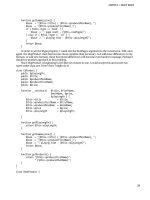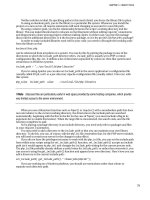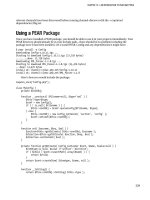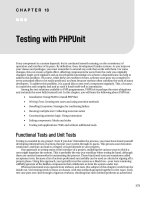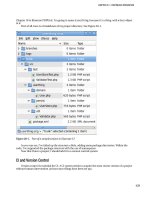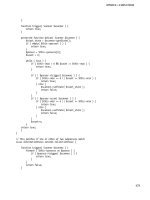Tài liệu PHP Objects, Patterns and Practice- P10 docx
Bạn đang xem bản rút gọn của tài liệu. Xem và tải ngay bản đầy đủ của tài liệu tại đây (1020.09 KB, 50 trang )
CHAPTER 20 ■ CONTINUOUS INTEGRATION
429
Chapter 18 to illustrate PHPUnit. I’m going to name it userthing, because it's a thing, with a User object
in it.
First of all, here is a breakdown of my project directory. See Figure 20–1.
Figure 20–1.
Part of a sample project to illustrate CI
As you can see, I’ve tidied up the structure a little, adding some package directories. Within the
code, I’ve supported the package structure with the use of namespaces.
Now that I have a project, I should add it to a version control system.
CI and Version Control
Version control is essential for CI. A CI system needs to acquire the most recent version of a project
without human intervention (at least once things have been set up).
Please purchase PDF Split-Merge on www.verypdf.com to remove this watermark.
CHAPTER 20 ■ CONTINUOUS INTEGRATION
430
You may have noticed that I moved the code for userthing into a directory named trunk. That’s
because I’m going to import the project into Subversion, and the branches, tags and trunk directories
are a useful convention in that system.
Here’s the import:
$ svn import userthing.orig/ file:///var/local/svn/userthing -m'first import'
And here's the checkout.
$ svn checkout file:///var/local/svn/userthing/trunk userthing
I covered Subversion in more detail in Chapter 17.
Now that I have the a local version of my project, I’m going to change my working directory to src/
in order to try out the various tools that my CI implementation will require.
$ cd userthing/src
Unit Tests
Unit tests are the key to continuous integration. It’s no good successfully building a project that
contains broken code. I covered unit testing with PHPUnit in Chapter 18. If you’re reading out of order,
though, you’ll want to install this invaluable tool before proceeding.
$ pear channel-discover pear.phpunit.de
$ pear install phpunit
Also in Chapter 18 I wrote tests for a version of the userthing code I’ll be working with in this
chapter. Here I run them once again, to make sure my reorganization has not broken anything new.
$ phpunit test
PHPUnit 3.4.11 by Sebastian Bergmann.
.....
Time: 0 seconds, Memory: 4.50Mb
OK (5 tests, 6 assertions)
As you can see, I referenced the filesystem to invoke my tests. I passed the test directory as an
argument to PHPUnit, and it automatically sought out my test files. However, one of the CI tools you’ll
encounter later, phpUnderControl, prefers that you reference a single class in order to run tests. To
support this requirement, I can add a test suite class. Here is UserTests.php:
require_once 'PHPUnit/Framework.php';
require_once 'test/UserStoreTest.php';
require_once 'test/ValidatorTest.php';
class UserTests {
public static function suite() {
$suite = new PHPUnit_Framework_TestSuite();
$suite->addTestSuite('UserStoreTest');
$suite->addTestSuite('ValidatorTest');
Please purchase PDF Split-Merge on www.verypdf.com to remove this watermark.
CHAPTER 20 ■ CONTINUOUS INTEGRATION
431
return $suite;
}
}
■
Note In in this case I've kept my test classes in the global namespace. Where tests have a close or one to one
relationship to the components they test, however, it's often neater to place each test class in the same
namespace as its target, and in a parallel directory structure. That way you can tell at a glance the relationship
between a test and its subject both from the test's namespace and the location of its file.
The PHPUnit_Framework_TestSuite class allows you to collect individual test cases into a suite. Here’s
how I can call this from the command line:
$ phpunit test/UserTests
PHPUnit 3.4.11 by Sebastian Bergmann.
.....
Time: 1 second, Memory: 4.50Mb
OK (5 tests, 6 assertions)
Documentation
Transparency is one of the principles of CI. When you're looking at a build in a Continuous
Integration environment, therefore, it’s important to be able to check that the documentation is up to
date, and covers the most recent classes and methods. I examined phpDocumentor in Chapter 16, so
I’ve already run an install like this.
pear upgrade PhpDocumentor
I’d better run the tool just to be sure:
$ mkdir docs
$ phpdoc --directory userthing --target docs/
That generates some pretty bare documentation. Once that’s published on a CI server, I’m sure to
be shamed into writing some real inline documentation.
Code Coverage
It’s no good relying on tests if they don’t apply to the code you have written. PHPUnit includes the
ability to report on code coverage. Here's an extract from PHPUnit’s usage information.
--coverage-html <dir> Generate code coverage report in HTML format.
--coverage-clover <file> Write code coverage data in Clover XML format.
--coverage-source <dir> Write code coverage / source data in XML format.
Please purchase PDF Split-Merge on www.verypdf.com to remove this watermark.
CHAPTER 20 ■ CONTINUOUS INTEGRATION
432
In order to use this feature you must have the Xdebug extension installed. You can find more about
this at (installation information at
You may also be able to install directly using your Linux
distribution’s package management system. This should work for you in Fedora 12, for example:
$ yum install php-pecl-xdebug
Here I run PHPUnit with code coverage enabled.
$ mkdir /tmp/coverage
$ phpunit --coverage-html /tmp/coverage test
PHPUnit 3.4.11 by Sebastian Bergmann.
.....
Time: 0 seconds, Memory: 5.25Mb
OK (5 tests, 6 assertions)
Generating code coverage report, this may take a moment.
Now you can see the report in your browser. See Figure 20–2.
Figure 20–2.
The code coverage report
It’s important to note that achieving full coverage is not the same as adequately testing a system. On
the other hand, it’s good to know about any gaps in your tests. As you can see from Figure 20–2, I’ve still
got some work to do.
Please purchase PDF Split-Merge on www.verypdf.com to remove this watermark.
CHAPTER 20 ■ CONTINUOUS INTEGRATION
433
Coding Standards
I can argue all day about the best place to put a brace, whether to indent with tabs or spaces, how to
name a private property variable. Wouldn’t it be nice if I could enforce my prejudices with a tool? Thanks
to PHP_CodeSniffer I can. CodeSniffer can apply one of a set of coding standards to a project and
generate a report, telling you just how bad your style is.
That might sound like a massive pain in the rear end. In fact, it can be just that. But there are
sensible non-passive aggressive uses for a tool like this. I’ll get to these, but first I’ll put the tool through
its paces. Installation first:
$ sudo pear install PHP_CodeSniffer
Now I’m going to apply the Zend coding standard to my code:
$ phpcs --standard=Zend userthing/persist/UserStore.php
FILE: ...userthing/src/userthing/persist/UserStore.php
--------------------------------------------------------------------------------
FOUND 10 ERROR(S) AND 0 WARNING(S) AFFECTING 8 LINE(S)
--------------------------------------------------------------------------------
6 | ERROR | Opening brace of a class must be on the line after the definition
7 | ERROR | Private member variable "users" must contain a leading underscore
9 | ERROR | Opening brace should be on a new line
13 | ERROR | Multi-line function call not indented correctly; expected 12
| | spaces but found 16
...
Clearly, I’d have to adjust my style to submit code to Zend!
It makes sense however, for a team to define coding guidelines. In fact, the decision as to which set
of rules you choose is probably less important than the decision to abide by a common standard in the
first place. If a codebase is consistent, then it’s easier to read, and therefore easier to work with. Naming
conventions, for example, can help to clarify the purpose of variables or properties.
Coding conventions can play a role in reducing risky or bug-prone code as well.
This is a dangerous area, though. Some style decisions are highly subjective, and people can be
disproportionately defensive about their way of doing things. CodeSniffer allows you to define your own
rules, so I suggest that you get buy in from your team on a set of rules so that no one feels that their
coding life has become a coding nightmare.
Another benefit of an automated tool is its impersonal nature. If your team does decide to impose a
set of coding conventions, it’s arguably better having a humorless script correcting your style, than a
humorless co-worker doing the same thing.
PHP Code Browser
You may be wedded to your exciting IDE or, like me, you might prefer to edit with vi. Either way,
when you’re looking at a report that tells you your style is lousy, or, more important, trying to
understand a failed test, it’s good to be able to pull up the code right away. The PHP_CodeBrowser
package lets you do just that.
This is bleeding-edge code, so to install you need to tell PEAR that you’re ready to accept an alpha
release.
$ sudo pear config-set preferred_state alpha
Please purchase PDF Split-Merge on www.verypdf.com to remove this watermark.
CHAPTER 20 ■ CONTINUOUS INTEGRATION
434
config-set succeeded
Then you can install.
$ pear install --alldeps phpunit/PHP_CodeBrowser
downloading PHP_CodeBrowser-0.1.2.tgz ...
Starting to download PHP_CodeBrowser-0.1.2.tgz (76,125 bytes)
.................done: 76,125 bytes
install ok: channel://pear.phpunit.de/PHP_CodeBrowser-0.1.2
If all goes well, you’ll have a command line tool called phpcb available. I’m going to point it at my
source code. phpcb likes to have access to log files generated by PHPUnit, so first I’ll run the tests first.
$ mkdir log
$ phpunit --log-junit log/log.xml test/
Now I can run phpcb:
$ mkdir output
$ phpcb --log log --output output/ --source userthing/
This writes files to the output directory. Figure 20–3 shows the output, which you can get by opening
the generated index.html file in a browser.
Please purchase PDF Split-Merge on www.verypdf.com to remove this watermark.
CHAPTER 20 ■ CONTINUOUS INTEGRATION
435
Figure 20–3.
PHP code browser
Build
While it’s possible to assess code in place, you should all also check that you can build and deploy a
package. To that end, I’ve included a package.xml file in my package. Here I test the build and install
stages.
$ pear package
Analyzing userthing/domain/User.php
Analyzing userthing/util/Validator.php
Analyzing userthing/persist/UserStore.php
Warning: in UserStore.php: class "UserStore" not prefixed with package name "userthing"
Warning: in Validator.php: class "Validator" not prefixed with package name "userthing"
Warning: in User.php: class "User" not prefixed with package name "userthing"
Warning: Channel validator warning: field "date" - Release Date "2010-03-07" is not today
Package userthing-1.2.1.tgz done
Tag the released code with `pear svntag package.xml'
(or set the SVN tag userthing-1.2.1 by hand)
Please purchase PDF Split-Merge on www.verypdf.com to remove this watermark.
CHAPTER 20 ■ CONTINUOUS INTEGRATION
436
Some of those warnings are a little out of date, since my classes use namespaces rather than the
package underscore convention. Nevertheless, I have a successful build. Now to deploy.
$ pear install --force userthing-1.2.1.tgz
install ok: channel://pear.appulsus.com/userthing-1.2.1
So I have a lot of useful tools I can use to monitor my project. Of course, left to myself I’d soon lose
interest in running them. In fact, I’d probably revert to the old idea of an integration phase, and pull out
the tools only when I’m close to a release, by which time their effectiveness as early warning systems will
be irrelevant. What I need is a CI server to run the tools for me.
CruiseControl and phpUnderControl
CruiseControl is a Continuous Integration server written in Java. It was released by ThoughtWorks (the
company that employs Martin Fowler) in 2001. Version 2.0, a complete rewrite was released in late 2002.
According to directives in a configuration file (config.xml) CruiseControl kicks off a build loop for
the projects it manages. For each project this involves any number of steps, which are defined in an Ant
build file (remember, Ant is the original Java tool upon which Phing is based). Once the build has been
run, CruiseControl, again according to configuration, can invoke tools to build reports.
The results of a build are made available in a Web application, which is the public face of
CruiseControl.
We could configure CruiseControl to run any tools we want, and to generate reports for us, after all
CruiseControl is designed to glue any number of test and build systems together. It would take a fair
amount of work though. I’m sure you’d like something off the peg that already integrates some of the
PHP tools you’ve already seen. phpUnderControl provides exactly that functionality. It customizes
CruiseControl so that tools like PHPUnit and CodeSniffer are run, and their reports integrated into the
Web interface.
Before I can use phpUnderControl, though, I must install CruiseControl.
■
Note Why CruiseControl? CruiseControl is well established, and it has an excellent pedigree having been
developed by ThoughtWorks. It’s free and open source. Tools that support integration with PHP are under active
development. The fact that many of these are hosted at phpunit.de bodes well for continuing support and
interoperability. There are many CI server solutions out there, however. If you’re looking for a native PHP
implementation, you should definitely take a look at Xinc (
/>).
Installing CruiseControl
CruiseControl is a Java system, so you will need to have Java installed. How you go about this will
vary from system to system. On a Fedora distribution you might do something like
yum install java-1.6.0-openjdk-devel
In a Debian system this should do the job
Please purchase PDF Split-Merge on www.verypdf.com to remove this watermark.
CHAPTER 20 ■ CONTINUOUS INTEGRATION
437
sudo apt-get install sun-java6-jdk
Otherwise, you can get Java directly from www.java.com.
Once you’ve confirmed that you have java (the java website will tell you if you haven’t), you need to
acquire CruiseControl. You can download the latest version at
You should end up with an archive named
something like cruisecontrol-bin-2.8.3.zip. Now you can move the directory somewhere central, and
launch the CruiseControl script.
$ unzip cruisecontrol-bin-2.8.3.zip
$ mv cruisecontrol-bin-2.8.3 /usr/local/cruisecontrol
$ cd /usr/local/cruisecontrol/
$ export JAVA_HOME=/usr/lib/jvm/java-1.6.0-openjdk/
$ ./cruisecontrol.sh
Notice that export line. Like many Java applications CruiseControl needs to know where your java
executable resides. You can see where that is on my system. Your system may differ. You can try
something like
ls -al `which java`
or
locate javac | grep bin
to find the directory you should use for JAVA_HOME. The java and javac (that’s the java compiler)
binaries will usually be found in a directory named bin. You should include the parent directory, and not
bin itself, in JAVA_HOME.
■
Note Once you’ve got your proof of concept up and running, you may want ensure that CruiseControl starts up
automatically when you boot your integration server. An excellent blog entry by Felix De Vliegher at
/> includes a start-up script for
CruiseControl.
If all goes well, you should see some text scroll by, but that’s about all. Once you’ve recovered from
the sense of anti-climax, you can really find out whether you’re ready to proceed by firing up your
browser and visiting http://localhost:8080/dashboard. You should see something like the screen in
Figure 20–4.
Please purchase PDF Split-Merge on www.verypdf.com to remove this watermark.
CHAPTER 20 ■ CONTINUOUS INTEGRATION
438
Figure 20–4.
The CruiseControl Dashboard screen
■
Note I’m running CruiseControl locally on my development box, so my URLs all point to localhost. You can, of
course, use a different host for your CI Server.
Installing phpUnderControl
Like CruiseControl, phpUnderControl exists to marshal other tools. So you need to make sure that
you have some prerequisites in place. I've already set up some of the tools this chapter. There’s one
more to install though:
$ pear channel-discover components.ez.no
$ pear install -a ezc/Graph
The ezcGraph package is used to generate useful status information. Now that it's in place, I can
install phpUnderControl itself.
$ pear config-set preferred_state beta
$ pear channel-discover pear.phpunit.de
$ pear install --alldeps phpunit/phpUnderControl
As you can see, phpUnderControl remains beta software at the time of this writing. Once I have it
installed, I should have access to a command line tool: phpuc. You can check this, with the usage flag:
Please purchase PDF Split-Merge on www.verypdf.com to remove this watermark.
CHAPTER 20 ■ CONTINUOUS INTEGRATION
439
$ phpuc --usage
Usage: phpuc.php <command> <options> <arguments>
For single command help type:
phpuc.php <command> --help
Available commands:
* clean Removes old build artifacts and logs for a specified project.
* delete Deletes a CruiseControl project with all logs and artifacts.
* example Creates a small CruiseControl example.
* graph Generates the metric graphs with ezcGraph
* install Installs the CruiseControl patches.
* merge-phpunit Merges a set of PHPUnit logs into a single new file.
* project Creates a new CruiseControl project.
So, I’ve already installed the package onto my system. Now I need to amend the CruiseControl
environment to support phpUnderControl. As you can see, phpuc provides a second installation step: a
command named install.
■
Note This two-part installation mechanism is a useful one. PEAR is good at getting library code, runnable
scripts, and supporting data files in place. When it comes to complex installation for things like Web applications
and database driven systems, it’s often a good idea to provide a configurable installation command as part of your
application. Of course, Phing would be a good choice for this secondary installation. Most users won’t have Phing
to hand though, so it can be better to build the installation logic into an application command.
$ phpuc install /usr/local/cruisecontrol/
Now to restart CruiseControl
$ cd /usr/local/cruisecontrol/
$ kill `cat cc.pid`
$ ./cruisecontrol.sh
CruiseControl stores its process id in a file called cc.pid. I use that to kill the current process, then I
run the cruisecontrol.sh script to restart. Now, I can visit http://localhost:8080/cruisecontrol/ to
confirm that CruiseControl had been rebranded. You can see the new interface in Figure 20–5.
Please purchase PDF Split-Merge on www.verypdf.com to remove this watermark.
CHAPTER 20 ■ CONTINUOUS INTEGRATION
440
Figure 20–5.
phpUnderControl
Now that I have phpUnderControl in place, somehow I need to get CruiseControl to acquire and
build the userthing project.
Installing Your Project
I’m a coder. I love fiddling around with text editors. But, like many, I hate writing configuration files.
So I’m lucky that phpuc provides me with a tool to generate the directories and configuration for my
project.
■
Note Remember I installed CruiseControl at
/usr/local/cruisecontrol
. All files and directories discussed in
this section are relative to that location.
If I were to add userthing to CruiseControl manually, I’d start by editing a configuration file called
config.xml, which can be found at the top level of the CruiseControl directory. In that file I’d tell
CruiseControl that it should recognize the project, as well as telling it about some key locations, the
build schedule. I’d set up some publishers that help to build reports.
Then I’d create a working directory called userthing within the projects directory. Probably the
most important file within the userthing project directory is named build.xml. You encountered files
with this name in Chapter 19. Phing is based on Ant, and Ant is the tool that CruiseControl uses to build
its projects and to run any assessment tools. The syntax for Ant and Phing build files is identical.
There’s quite a learning curve to setting up CruiseControl. There’s an excellent reference to the
config.xml file at which documents 123
XML elements at the time of this writing. You’ll likely use it when you start to delve deeper into CI. As
Please purchase PDF Split-Merge on www.verypdf.com to remove this watermark.
CHAPTER 20 ■ CONTINUOUS INTEGRATION
441
useful as the documentation is, it might give you the impression that you won’t be up and running with
a build and test cycle any time soon.
phpuc comes to the rescue, though, with the project command. This creates the required files and
directories, and amends any configuration files.
phpuc project --source-dir src \
--version-control svn \
--version-control-url file:///var/local/svn/userthing/trunk \
--test-dir test \
--test-case UserTests \
--test-file UserTests.php \
--coding-guideline Zend \
--project-name userthing \
/usr/local/cruisecontrol/
■
Note If I were running CruiseControl on system remote from my version control repository, I’d also want to set
the
user
and
password
options.
Much of this should be self-explanatory. CruiseControl will need access to the userthing source, so,
through phpuc, I need to tell it I’m using Subversion, and provide it with the URL for the code. Then I tell
it where to find the tests, the coding standard I wish to apply. To set things up, phpUnderControl needs
to know where to find the cruisecontrol directory, so I provide the path. The output of the phpuc
project command gives you a good idea of the work that needs to be done in order to pass on this
information.
Performing project task.
1. Creating project directory: projects/userthing
2. Creating source directory: projects/userthing/source
3. Creating build directory: projects/userthing/build
4. Creating log directory: projects/userthing/build/logs
5. Creating build file: projects/userthing/build.xml
6. Creating backup of file: config.xml.orig
7. Searching ant directory
8. Modifying project file: config.xml
Performing checkout task.
1. Checking out project.
2. Preparing config.xml file.
3. Preparing build.xml checkout target.
Performing PhpDocumentor task.
1. Creating apidoc dir: project/userthing/build/api
2. Modifying build file: project/userthing/build.xml
3. Modifying config file: config.xml
Performing PHP_CodeSniffer task.
1. Modifying build file: project/userthing/build.xml
Performing PHPUnit task.
1. Creating coverage dir: project/userthing/build/coverage
2. Modifying build file: project/userthing/build.xml
3. Modifying config file: config.xml
Please purchase PDF Split-Merge on www.verypdf.com to remove this watermark.
CHAPTER 20 ■ CONTINUOUS INTEGRATION
442
Performing PHP_CodeBrowser task.
1. Creating browser dir: project/userthing/build/php-code-browser
2. Modifying config file: config.xml
Performing ezcGraph task.
1. Modifying config file: config.xml
phpuc helpfully tells you exactly what it’s up to. As you can see it amends one or both of config.xml
and build.xml for each of the tasks I want CruiseControl to run.
By the time you read this, running phpuc in this way might be enough to get you up and running. At
the time of this writing though, there are a few issues that must first be addressed. phpUnderControl is a
beta product, after all.
First of all phpuc writes an element to the config.xml file that CruiseControl 2.8.3 chokes on. If you
find this line in config.xml:
<currentbuildstatuspublisher file="logs/${project.name}/buildstatus.txt"/>
and either comment it out, or delete it, you should avoid a fatal error.
Secondly, phpuc writes a call to itself into the main configuration file at config.xml. Here’s the
relevant section:
<project name="userthing" buildafterfailed="false">
<!-- ... -->
<publishers>
<!-- ... -->
<execute command="/usr/bin/phpuc graph logs/${project.name}
artifacts/${project.name}"/>
</publishers>
</project>
CruiseControl allows you to add your own publishers to provide custom reports for the user.
Unfortunately, there is a bug with the phpuc graph command that, at the time of this writing, prevents
the command from running. The workaround is to remove a file from the PEAR repository:
$ rm /usr/share/pear/phpUnderControl/Graph/Input/ClassComplexityInput.php
where /usr/share/pear is my PEAR directory. You can find yours with the command:
$ pear config-get php_dir
Since this problem may be fixed by now, you might skip this step, but bear it mind if the project
metrics reports are not generated.
Lastly, I must make a change that is related to my setup, rather than to a problem with the phpuc
command. I like to keep my source code in a subdirectory (named src/) within my project. That way I
can add housekeeping scripts, documentation, and other miscellanea at the top level. phpuc asks me to
specify the test directory in my command line arguments, but it will construct a call from the root of my
source directory. So if I tell phpuc that my test directory is to be found at src/test/ and that my test suite
is in UserTests.php, it will construct a call to src/test/UserTest.php.
Because my tests are designed to be run from the src/ directory, this will fail. All my require
statements use paths that are relative to src/ as a starting point, and not its parent directory. Showing
you how to change this also gives us the opportunity to take a quick look at the build.xml file.
Please purchase PDF Split-Merge on www.verypdf.com to remove this watermark.
CHAPTER 20 ■ CONTINUOUS INTEGRATION
443
■
Note A reminder of the CruiseControl environment:
config.xml
sits at the top level and handles application wide
configuration. Project specific build targets live in an Ant file at
projects/userthing/build.xml
. phpUnderControl
created the
userthing
directory and the build file on my behalf when I ran the
phpuc project
command.
Here’s the phpunit task, and some context.
<?xml version="1.0" encoding="UTF-8"?>
<project name="userthing" default="build" basedir=".">
<target name="build" depends="checkout,php-documentor,php-codesniffer,phpunit"/>
<!-- ... -->
<target name="phpunit">
<exec executable="phpunit" dir="${basedir}/source" failonerror="on">
<arg line=" --log-junit ${basedir}/build/logs/phpunit.xml
--coverage-clover ${basedir}/build/logs/phpunit.coverage.xml
--coverage-html ${basedir}/build/coverage UserTests test/UserTests.php"/>
</exec>
</target>
</project>
As you can see, this is just the same as a Phing document. It’s divided into target elements, which
relate to one another via their depends attributes. The phpunit task would fail as it stands. It’s calling
test/UserTest.php, but from the context of ${basedir}/source. In order to make this work, all I need do
is amend the exec element, so that it runs from ${basedir}/source/src.
<exec executable="phpunit" dir="${basedir}/source/src" failonerror="on">
Now, I’m about ready to run my project.
Running phpUnderControl / CruiseControl
First of all I need to restart CruiseControl:
$ kill `cat cc.pid`
$ ./cruisecontrol.sh
Now, I can see the results of my initial build by visiting http://localhost:8080/cruisecontrol. The
control panel should show that the userthing project has been added, and indicate the outcome of the
build. Clicking on the project name will call up the Overview screen.
You can see this screen in Figure 20–6.
Please purchase PDF Split-Merge on www.verypdf.com to remove this watermark.
CHAPTER 20 ■ CONTINUOUS INTEGRATION
444
Figure 20–6.
The Overview screen
As you can see, the build went well, although CodeSniffer is complaining about my style. I can get
the full whine by clicking on the CodeSniffer tab, or I can see the complaints in the context of the code
itself by clicking on Code Browser. Figure 20–7 shows the code browser with the contextual
errors/notices tab open.
Figure 20–7.
The code browser showing “Errors”
Please purchase PDF Split-Merge on www.verypdf.com to remove this watermark.
CHAPTER 20 ■ CONTINUOUS INTEGRATION
445
Most of the tools I tested earlier are available inline through these tabs. I can check code coverage,
examine test results, and browse documentation. And I can be secure that CruiseControl will regularly
update the project and run a build (every five minutes by default). I can see an overview by clicking on
the Metrics tab. You can see this screen in Figure 20–8.
Figure 20–8.
The Metrics screen
Test Failures
So far everything seems to be going well, even if userthing won’t be finding its way into the Zend
codebase any time soon. But tests succeed when they fail, so I'd better break something to make sure
that CruiseControl reports on it.
Here is a part of a class named Validate in the namespace userthing\util:
public function validateUser( $mail, $pass ) {
// make it always fail!
return false;
$user = $this->store->getUser( $mail );
if ( is_null( $user ) ) {
return null;
}
if ( $user->getPass() == $pass ) {
return true;
}
Please purchase PDF Split-Merge on www.verypdf.com to remove this watermark.
CHAPTER 20 ■ CONTINUOUS INTEGRATION
446
$this->store->notifyPasswordFailure( $mail );
return false;
}
See how I’ve sabotaged the method? As it now stands validateUser() will always return false.
Here's the test that should choke on that. It’s in test/ValidatorTest.php:
public function testValidate_CorrectPass() {
$this->assertTrue(
$this->validator->validateUser( "", "12345" ),
"Expecting successful validation"
);
}
Having made my change, all I need do is commit, and wait. Sure enough, before long, my status page
highlights userthing in an alarming orangey red. Once I’ve clicked on the project name, I select the
Tests tab. You can see the error report in Figure 20–9
Figure 20–9.
Failed tests
Failure Notification
It’s very well having errors reported on the CruiseControl web interface, so long as people visit
frequently. There is a danger that the system’s quiet efficiency might cause it to be forgotten. You can
Please purchase PDF Split-Merge on www.verypdf.com to remove this watermark.
CHAPTER 20 ■ CONTINUOUS INTEGRATION
447
change that by making CruiseControl a nag. In order to do this you can use a built-in publisher: email,
which you should add to the publishers element in your project's section of the config.xml file:
<email mailhost="smtp.somemail.com"
mailport="465"
username=""
password="somepass"
usessl="true"
returnaddress=""
buildresultsurl="http://localhost:8080/cruisecontrol/buildresults/${project.name}"
returnname="CruiseControl">
<always address="" />
<failure address="" reportWhenFixed="true" />
</email>
The email element contains all the information needed to connect to a mail server. I've assumed
that an SSL connection is required, but you could omit the mailport and and usessl elements otherwise.
The always element defines an address to which a message should be sent for all builds whether
successful or not. The failure element defines an address to which failure notifications should be sent.
As a bonus, with reportWhenFixed set to true, the failure recipient will also get an all clear message when
a builds are once again successful.
The failure message is very short, consisting of a subject line, which gives the build status and a URL
for the full report.
■
Note If you want more verbose messages you should look at the
htmlemail
publisher, which shares a common
set of attributes and child elements with the
publisher, but also provides additional options to help you
format an inline message. You can find more information about
htmlemail
at
Adding Your Own Build Targets
So far I have stuck to the toolset supported by phpUnderControl. That gets us a long way, after all.
However you should know that you can quite easily add your own checks to CruiseControl.
The biggest omission so far has been a test of for creating and installing a package. This is
significant, because CI is about build as well as testing. One approach would be to create a PHPUnit test
case which attempts to build and install a package.
In order to illustrate some of CruiseControl's features, though, I propose to perform the build and
install from within the product build file. I’ve already shown you the build target. It invokes the other
targets in the file through its depends attribute. Here I add a new dependency.
<target name="build"
depends="checkout,php-documentor,php-codesniffer,phpunit,install-package"/>
The install-package target does not exist yet. Time to add it.
<target name="make-package">
<exec executable="pear" dir="${basedir}/source/src"
Please purchase PDF Split-Merge on www.verypdf.com to remove this watermark.
CHAPTER 20 ■ CONTINUOUS INTEGRATION
448
failonerror="on"
output="${basedir}/build/builderror/index.txt">
<arg line=" package" />
</exec>
</target>
<target name="install-package" depends="make-package">
</target>
In fact install-package is currently empty. That’s because it depends on another new target, make-
package, which must be run first. There I use an Ant task called exec to invoke the command pear
package. This looks for a file called package.xml in the ${basedir}/source/src directory. How do I know
that this will be there? That's thanks to the checkout target in the same file that calls Subversion and
updates userthing under ${basedir}/source.
I send any error messages to a file in a directory at build/builderror using the output attribute.
Other tasks use the build directory so it's already in place, but builderror is new, so I need to create it
from the command line.
Once I restart CruiseControl I should see no difference. Once again, I’ll only see the benefit when
things change. So, it’s time to create an error. Here I poison my package.xml file:
<summary>A sample package that demo's aspects of CI</summary>
<wrong />
<description>Consisting of tests, code coverage, Subversion, etc
</description>
Once I’ve committed this, the pear package command will choke that wrong element there. It should
refuse to build the package. Because the exec element has a failonerror attribute set, the build will fail,
and CruiseControl should then alert the team.
Figure 20–10 shows the failed build in the CruiseControl Web interface.
Figure 20–10.
The build fails
Please purchase PDF Split-Merge on www.verypdf.com to remove this watermark.
